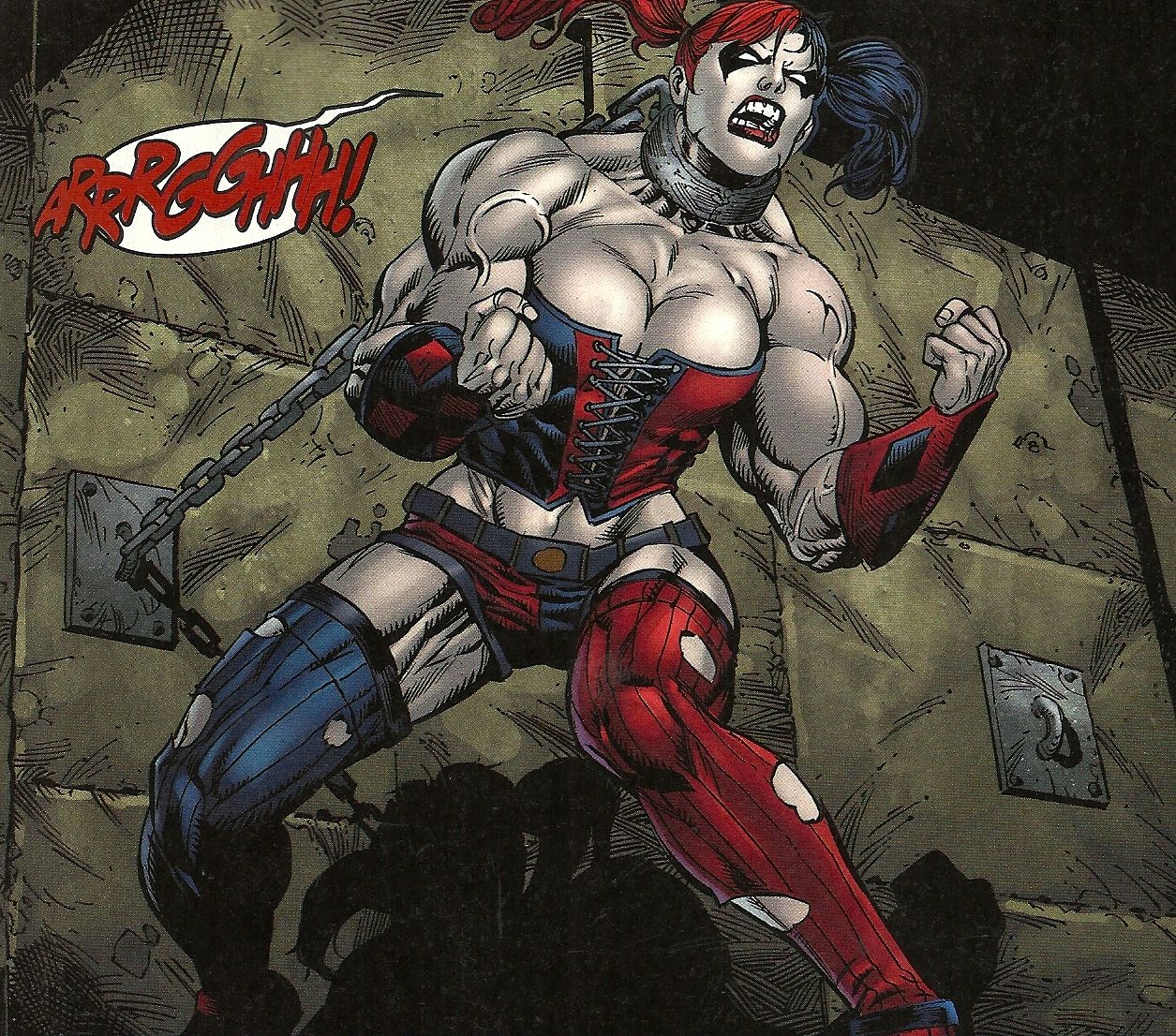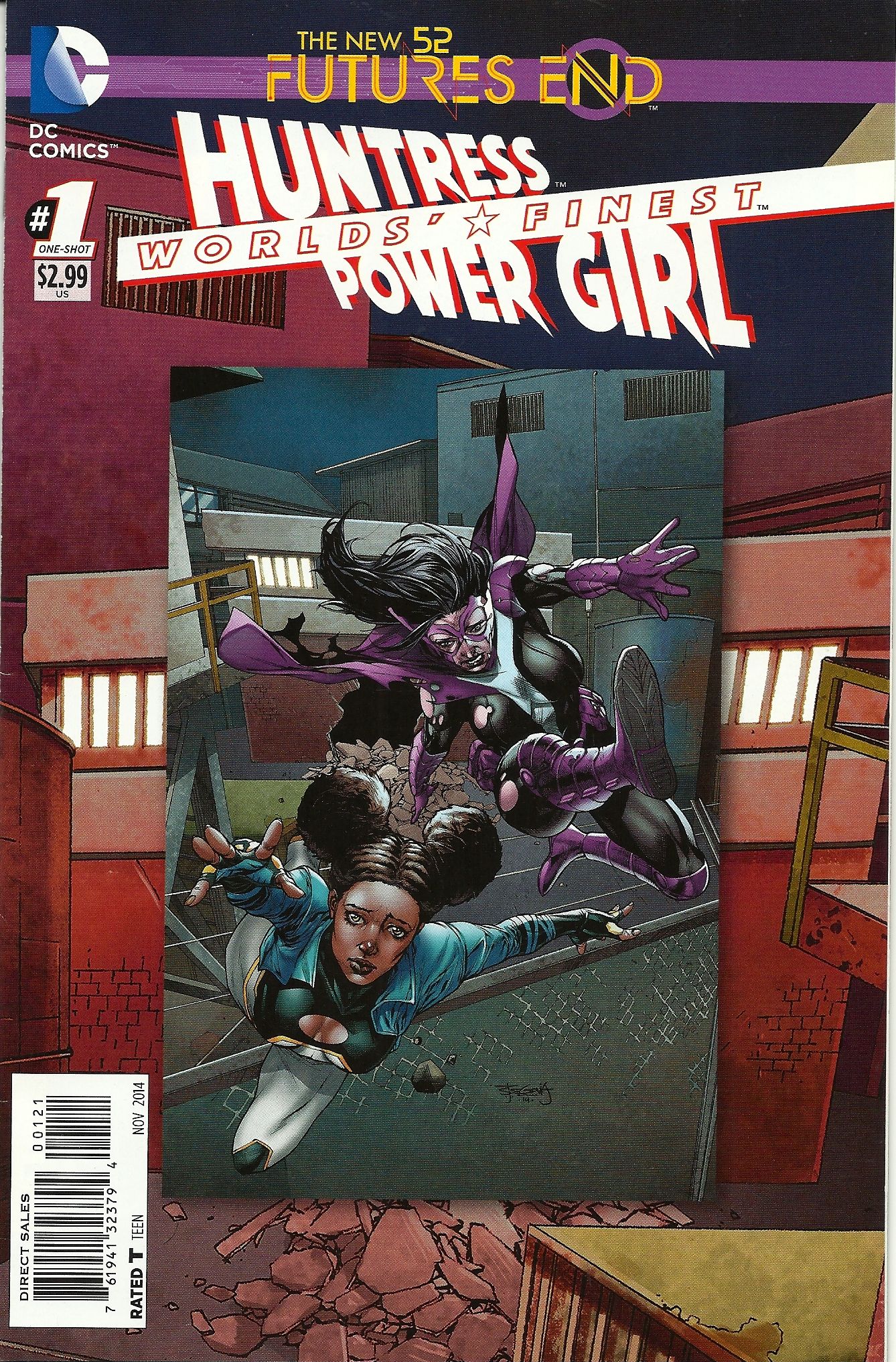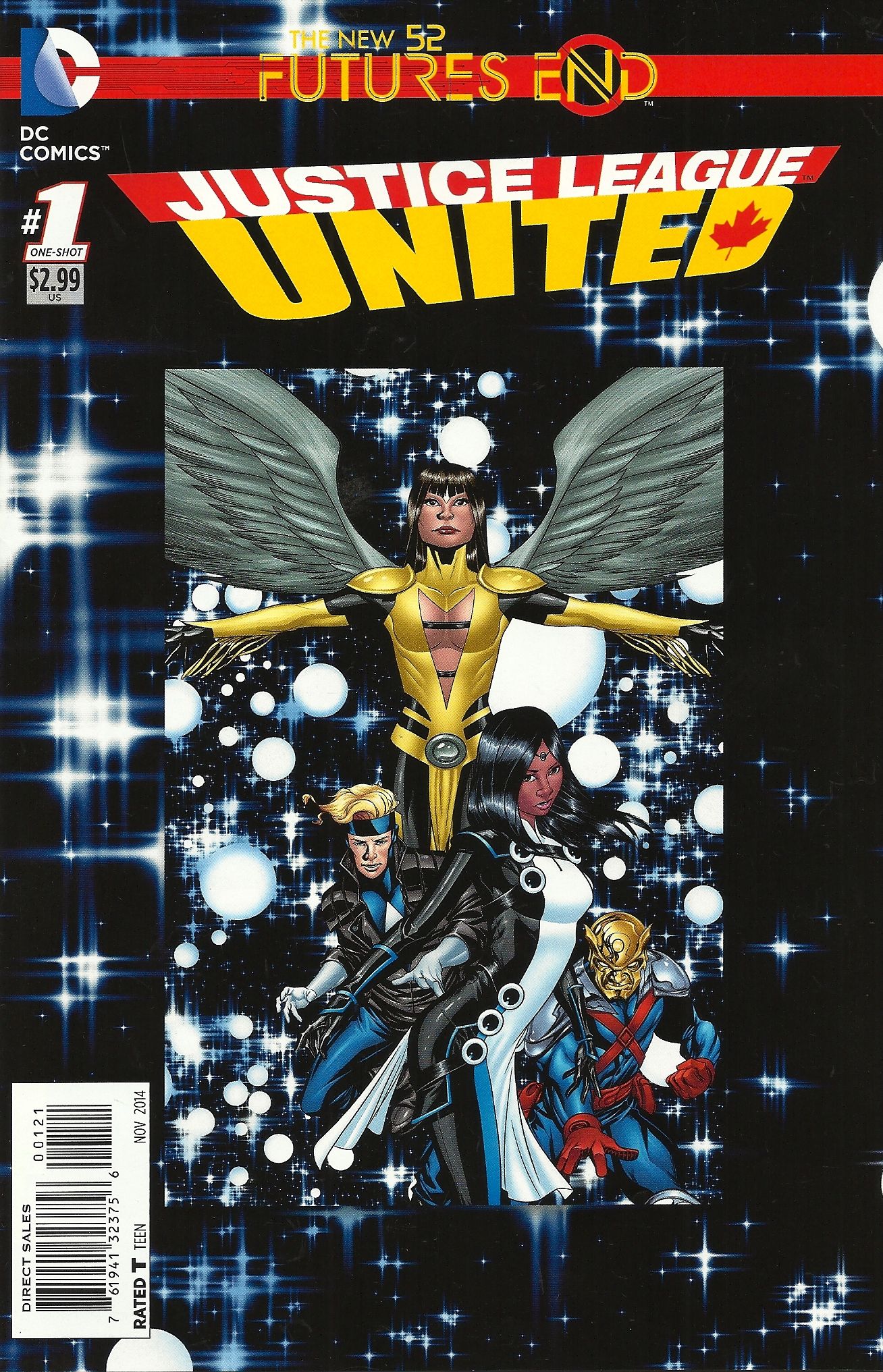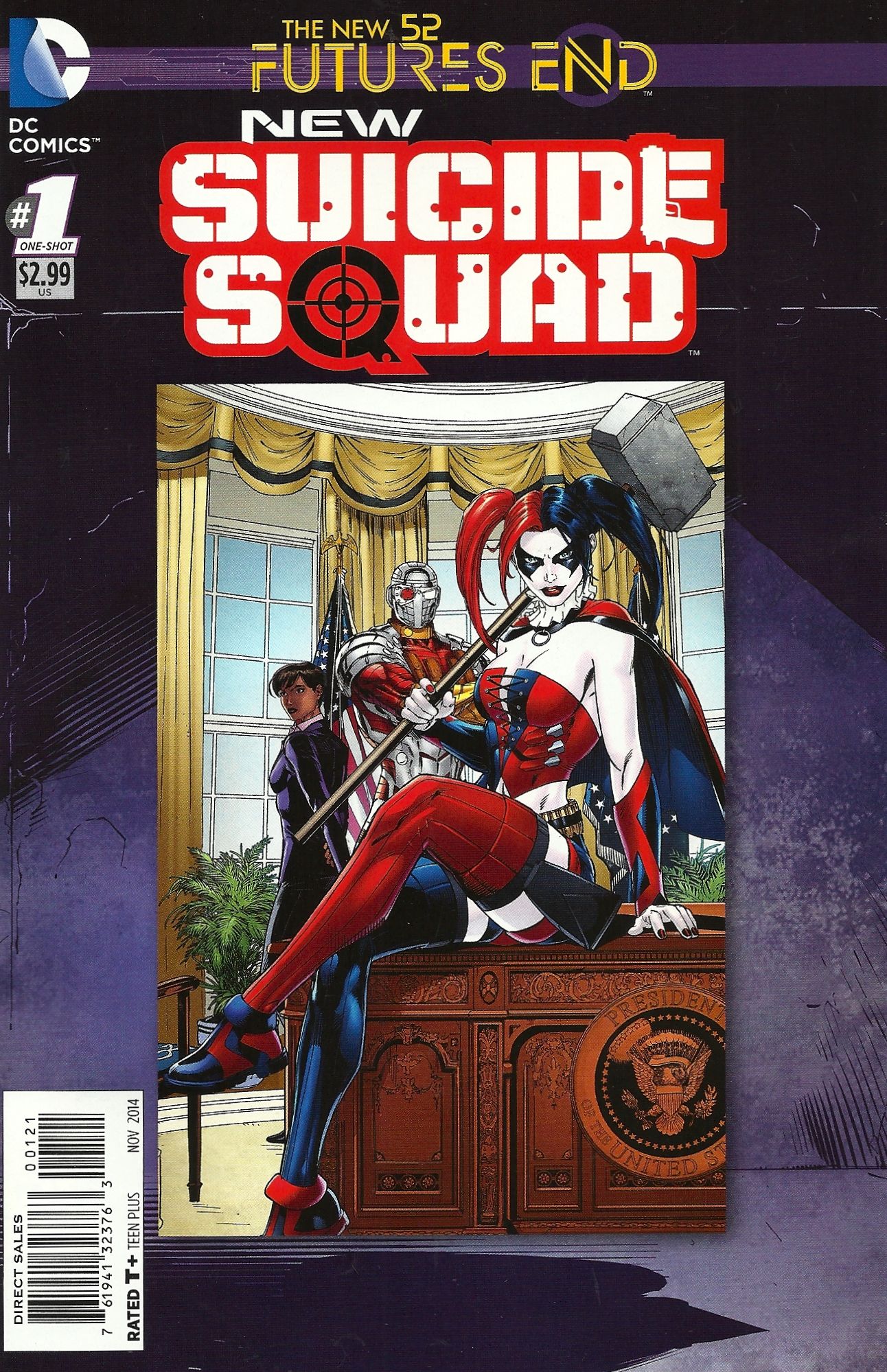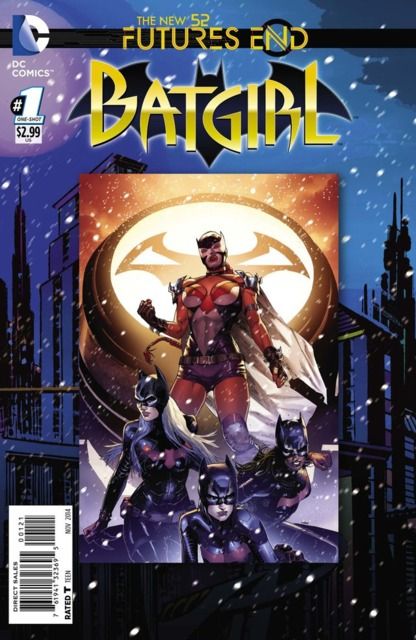This month marks the third anniversary of of the New 52, and, as was the case with each September since the 2011 relaunch of DC Comics' superhero titles, that means the entire line is being unified under an umbrella theme ... or gimmick, depending on how charitable you are.
In 2012, it was "Zero Month," with each book telling a story set in the hero's first year of rebooted continuity. Last year, it was "Villains Month," featuring fancy 3D covers, decimal-point issue numbers and stories starring DC's antagonists. This year, its a little from column A, and a little from column B: There are more of those fancy covers, but all of the stories are set five years into the future.
As I did last week, I've grabbed a handful of new Futures End one-shots, more or less at random, for review. This week DC released 10 Futures End one-shots, of which I have five sitting in a little stack next to me as I type. Last time, I tried ordering the reviews from worst to best, but I had trouble doing so this week, as there wasn't really a stand-out like Grayson. Rather, these five seemed to cluster around a baseline of mediocrity, with a few being slightly better, others slightly worse.
The one unifying element, however, is that they all seemed to contradict the events in the main Futures End series ... and/or the other one-shots I read, making for a rather frustrating read. If the idea was to expand the world of Futures End to include the entire DC line, it doesn't seem as if the writers and artists were all on the same page regarding what's going on in the primary series or in the other books featuring the characters and plots they would refer to, directly or indirectly.
Just so we're all on the same page, here's a quick recap of Futures End, which you can skip if you've been reading the weekly series, which published its 20th issue this week: Sentient satellite Brother Eye rules the nightmare future of 35 years from now, killing superheroes left and right, or turning them into cyborgs kill-bots. To prevent this from coming to pass, Batman Bruce Wayne sends Other Batman Terry McGinnis back in the past to kill Mr. Terrific before he can create Brother Eye.
Something goes wrong, however, and McGinnis instead lands in the nearer future of five years from now, when Brother Eye is already active, and a war between Earth 1, Earth 2 and Apokolips has radically changed many of the heroes of the present-day DC Universe. While McGinnis tries to salvage the far future, various characters with canceled books — Grifter, Deathstroke, Frankenstein, etc. — move through their own subplots involving things like Brainiac and a secret island gulag of Earth 2 prisoners.
Worlds' Finest: Futures End #1
Written by Paul Levitz, advised by Keith Giffen, drawn by Yildray Cinar and colored by Jason Wright
The most confusing logo of the New 52 line gets a little more confusing this month, with "The New 52: Futures End" stacked atop the awkwardly arranged "Huntress/Worlds' * Finest/Power Girl." It was after reading this issue that I began to wonder about the nature of some of these covers, as this one doesn't match up very closely to the contents of the book, and another matches up worse still.
When we last saw Power Girl in Futures End, at the end of Issue 18, she was hovering above Cadmus Island, using her super-senses to spy on the chaos below: Brother Eye had just taken control of all of the Earth 2 prisoners and set them free to hunt down the facility's staff, like Deathstroke, Earth 2 Lana Lang and Fifty Sue.
In this issue, we see Power Girl, wearing an entirely different costume and with her hair a good six inches longer, emerging from underground on Cadmus Island. She puts on a disguise and commences sneaking around the island in search of Huntress, until she is spotted and ends up in a fight with Deathstroke, Fifty Sue and the OMAC guards.
She receives some help from ... whoever that girl on the cover is who is not the Huntress (the issue seems to assume readers will know who she is, so I guess she's a recurring character in the title?), but the combined might of the two prove no match for Fifty Sue's powers. Soon the defeated Power Girl is tossed into a cell with a black-haired lady who may or may not be Huntress ... who isn't currently being mind-controlled by Brother Eye, for some reason.
Meanwhile, in this week's Futures End #19, Power Girl (wearing a different costume and her hair like she was in Issue 18) fights Deathstroke and Fifty Sue under entirely different circumstances; she was, like all of the other escaped Earth 2 captives, being controlled by Brother Eye, and the fight ends when Fifty Sue tells Brother Eye to knock it off.
Keith Giffen, one of Futures End's four co-writers gets a big "Advisor" credit in Worlds' Finest, but apparently he didn't advise hard enough, because this entire issue seems to directly contradict almost everything in Futures End's versions of the events.
It's sort of remarkable for just how opposite of a tie-in it is, though; I think DC might have just accidentally invented the untie-in with this issue.
Justice League United: Futures End #1
Written by Jeff Lemire, drawn by Jed Dougherty and colored by Gabe Eltaeb
This issue, the first of a two-part story that will conclude in Justice League: Futures End #1, should be one that is particularly closely tied to the ongoing events of the Futures End series (it's written by one of the weekly's quartet of writers, after all, and Lemire did a pretty good job of connecting last week's Green Arrow one-shot to the weekly). It should be, but it isn't.
Lemire's new character Equinox is fighting cyborg mad scientist The Polargeist and his robot polar bears (not to be confused with the polar bear SHADE's Father Time had hidden a robot implant in during the early issues of Futures End) in Canada, when she receives a psychic distress call from Martian Manhunter.
She goes to the last remaining member of her League, Animal Man, for help, but he tells her he's retired, and that she should go to the other Justice League for help. This, by the way, is the Justice League Equinox was already shown to be a part of as far back as Futures End #11. She travels to their headquarters, the Fortress of Justice in New Mexico (and not the satellite HQ shown in the pages of Futures End), where she finds a League with a somewhat-different roster from that in FE (Vostok and Dawnstar are in, Aquaman is out). They travel to their supervillain prison on Mars, where Martian Manhunter is the warden, in order to save him from a break-out in progress.
It's a perfectly fine, perfectly serviceable superhero story — save for the fact that it doesn't make sense in the context of the story it's sold as a tie-in to, co-written by its own writer. Dougherty's art is pretty nice, though, and his cyborg polar bears are particularly fun designs.
New Suicide Squad: Futures End #1
Written by Sean Ryan, penciled by Andre Coelho, inked by Scott Hanna and colored by Blond
The cover of this issue is so disconnected from the contents as to appear completely random. Tilt it one way, and you see Harley Quinn, Deadshot and Amanda Waller behind bars, tilt it the other way, and you see the trio in the Oval Office.
All three characters appear within this book, but they don't look like they do on the cover (in some cases, not even close). There's a scene set in a prison, but there isn't one set anywhere near the White House.
Five years from now, a buffer, heavily armed, tanktop- and undercut-rocking Amanda Waller breaks into a new, underground Belle Reeve to rescue her former Suicide Squaddies, all of whom have been radically transformed by experiments meant to make them more dangerous, but ultimately only served to break them.
Deadshot is missing his right arm, Black Manta has had his brain fried so that all he understands are martial arts moves and fish sticks, and Harley Quinn was pumped full of venom steroids, giving her a Hulk-like appearances (unlike her male peers, however, she still wears her costume, and has her hair and make-up done, while they wear prison uniforms and look rough).
Waller's gotten the team back together to help her shut down a government facility that's cloning villains to make "their own army of bad guys." She expects to merely find newborn clones awaiting the personalities of villains downloaded into them, but instead she finds a few that are already grown-up enough to be deadly. There's a pair of little-boy Jokers, and a teenage Deathstroke.
Despite some goofy elements, this book works well enough on its own as a possible future for the characters in the ongoing Suicide Squad, but it drastically contradicts the plot of a book that's practically guaranteed to be the most widely read of these one-shots (see below). The broken Deadshot vs. Teen Deathstroke battle is pretty cool, however, particularly the way in which our hero defeats his opponent.
Batman: Futures End #1
Written by Ray Fawkes and Scott Snyder, art by Aco and colored by Fco Plascencia
Again, completely divorced from the context of the linewide Futures End crossover that justifies its existence, this is a perfectly decent done-in-one story about a possible future Batman. It's scripted by Ray Fawkes, who co-plotted it along with Scott Snyder, and their premise is that, in the very near future (just five years from now, when Batman will still be in his 30s), Batman will be completely falling apart, physically.
To continue to wage his war on crime, he's using a high-tech suit and pumping himself full of drugs that give him about 45 minutes worth of old-fashioned, circa 2014, Batman bad-assery. But he has a plan: He's going to clone himself, and download his memory into his clone to continue to fight crime in Gotham ... forever!
This seems to be at odds with the portrayal of the Batman of five years from now we've already seen (briefly) in Futures End and (extensively) in last week's Detective Comics: Futures End.
In this comic, Batman has tried desperately to find the necessary MacGuffin to perfect his self-cloning project, but Lex Luthor has apparently devoted billions of dollars to wiping out all traces of cloning technology in the world, save for his own, which means if Batman wants to make a clone, he has no choice but to break into Lex Luthor's secret cloning lab.
The premise of this issue and that of the Suicide Squad are therefore mutually exclusive. Or maybe Batman and Lex simply don't read Suicide Squad, and thus had no idea that the U.S. government had perfected the process, and had a fairly easy to break into lab in Texas ...?
Luthor talks to Batman throughout the breaking-and-entering adventure, via a pre-recorded hologram message meant to taunt intruders, and it makes for a nice, amusing Batman vs. Luthor story (one that ties in rather nicely to their current frenemies plotline in Justice League).
Aco's art is extremely photo-reference heavy and computer-assisted, making for a rather unappealing (to my eye, anyway) package, but the storytelling is crystal clear, and the "sampling" the artist engages in during a panel showing Batman's army of legacy characters, including the black Robin from Detective Comics #27, is pretty amusing, mostly for who it includes and how they're depicted.
Batgirl: Futures End #1
Written by Gail Simone, drawn by Javier Garron and colored by Romulo Fajardo Jr.
I would like to take a moment to apologize to the New 52 Red Robin costume and the New 52 Wonder Girl costume, both of which I have repeatedly called the worst costumes ever. I was wrong to say it, costumes, but I had a pretty good excuse: I hadn't yet seen Barbara "The Beast" Gordon's costume in Batgirl: Futures End #1.
It consists of a Bane-style luchador mask with little bat-ears, a dog collar, a Spandex off-the-shoulder top with a bat-with-a-tail icon on it, a pair of short-shorts, biker gloves, off-the-shoulder shoulder pads that vaguely resemble reversed versions of ones The Shredder might wear and a cape.
It is very, very difficult to get past this costume, which can make reading this comic kind of tough, as that costume is on the cover.
It goes with Barbara Gordon's new identity in the near future: Bete Noir,The Black Beast or, simply,The Beast.
What happened? Well, two years from now, on her wedding night, Barbara Gordon's brother James Gordon Jr. attacked her and killed her husband, and she went a little off the deep end. She then spent a few years going undercover and dismantling the criminal operations of the likes of The Penguin and The Riddler before seeking out Bane, with whom she trained before returning to Gotham as what looks like the results of a Bane and Batman coupling, could such result in offspring.
She's also assembled "The League of Batgirls," which is actually a rather fun concept, and one that makes this a fairly decent "last" Batgirl story, as it features all three past girls and one new, future Batgirl. These Batgirls are Stephanie Brown, Cassandra Cain and Tiffany Lucille Fox (Stephanie's currently appearing as Spoiler in Batman Eternal; Cassandra hasn't made her New 52 debut, and I guess this possible future might not really "count" as such). They wear matching, terrible costumes, which look a little like Stephanie's, sans cape, and with lots of armor, joints, pouches and straps, perfect for the New 52. Each has their own highlight color: Purple for Stephanie, yellow for Cassandra and pink for Tiffany. No one gets a cape, except for Tiffany, but only in one panel.
And this is a last Batgirl comic, as it officially ends Simone's run on the New 52 iteration of the character, making way for the new creative team (and costume ... and direction) next month. It's somewhat schizophrenic in its tone and its portrayal of Barbara, but that too is sort of fitting, given the character's overall arc during the last three years (and the thirty-some before that).
Those are the ones I tried; how about you guys? Did I just happen to miss all the really good ones this week?

